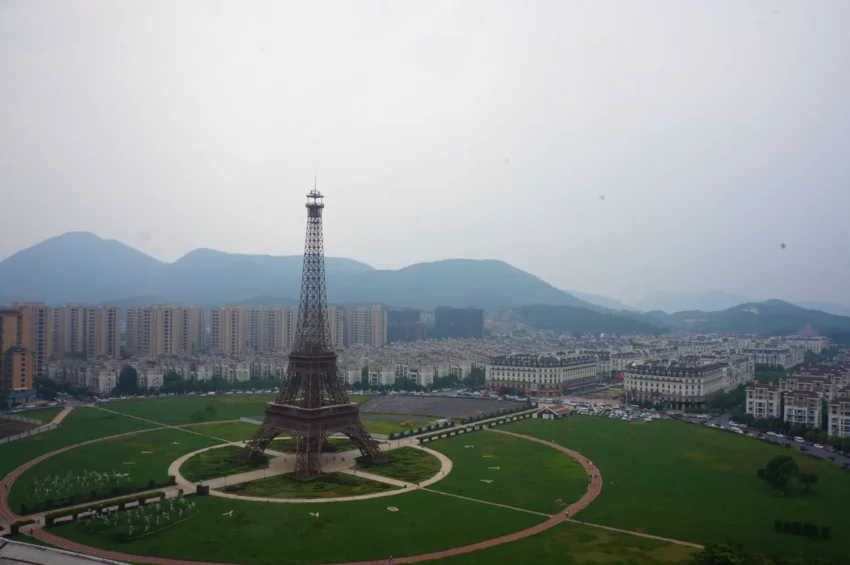Tianducheng: A Parisian Dreamscape in the Heart of China
The Tianducheng development in Hangzhou, Zhejiang Province, China, stands as a unique testament to the global fascination with the architectural grandeur of Paris. The area, inaugurated in 2007, epitomizes an ambitious attempt to recreate the essence of the famed European capital. As a product of the Zhejiang Guangsha Co. Ltd., Tianducheng is not merely a housing estate but encompasses a broader vision that includes an adjacent luxury hotel and other amenities designed to emulate Parisian lifestyle and aesthetics.
Get your dose of History via Email
Architectural Imitation and Ambience
At the core of Tianducheng’s allure is its strikingly detailed imitation of Parisian landmarks. It proudly showcases a 108-meter tall Eiffel Tower replica, approximately one-third of the height of the original in Paris. This iconic structure is complemented by other reproductions of Paris landmarks, which contribute to the Francophile ambience of the locale. Sculptures and fountains further evoke the Parisian spirit, albeit in a distinctly Chinese setting. The grounds are adorned with lawns and gardens, mirroring the meticulously maintained parks of France’s capital.
Social and Economic Ethos
With the capacity to accommodate upwards of 10,000 residents, Tianducheng envisions itself as more than a mere housing complex. It aspires to become a cradle of high-end urban living, offering a blend of residential comfort and touristic charm. Despite these aspirations, under-occupation was a prevailing theme in Tianducheng’s early years. This resulted in media depictions that ranged from being a grandiose endeavor to a ‘ghost town.’ Notwithstanding these portrayals, by the year 2013, Tianducheng had indeed found an audience. It hosted a population of approximately 2,000 individuals—far below its intended capacity, yet a sign of burgeoning life within its Parisian-styled borders.
Development and Urban Planning
Spanning an area of 31 square kilometers, Tianducheng’s development plans were nothing short of ambitious. The 5 square kilometers central area, which houses the core imitations of Paris, was to be enclosed by a further 26 square kilometers of supporting facilities and residential zones. Urban planning catered to a broad demographic, proposing settings from European-style villas to high-rise apartment complexes. Yet, the replication of a city’s spirit is as much about people as it is about architecture, and thus the success of such a venture is measured in the vibrancy of its community as much as in the fruition of its buildings.
Cultural Reverberations
Tianducheng serves as an intriguing cultural artifact, reflecting the nuanced interplay between globalization and local identity. While critics may highlight the inherent incongruity of transplanting a piece of Paris into a Chinese milieu, supporters of the project view it as a celebration of cross-cultural appreciation and architectural homage. Tianducheng, thus, remains a dynamic canvas upon which the narratives of East and West converge—an ongoing dialogue as residents and visitors interact with its Eurocentric sensibilities.
Comparative Urban Developments
It is worth noting that Tianducheng is not an isolated phenomenon within the context of Chinese urban development. China has seen multiple instances of Western architectural mimicry, reflecting a broader trend of themed towns that borrow the aesthetic and spirit of foreign locales. This trend is indicative of a particular strand of selective globalization, whereby certain elements of Western culture are assimilated into the Chinese way of life, resulting in unique, hybrid spaces of residence and leisure.
Conclusion
Tianducheng stands as a singular blend of ideology, urban planning, and cultural expression. As its population grows, and its identity continues to evolve, it presents a curious case study in the potency of architectural pastiche within the fabric of modern urban development. Whether as a case of cultural juxtaposition or as an imaginative cityscape offering residents a taste of the Parisian dream, Tianducheng exemplifies the complex gestures toward Western emulation evident in contemporary Chinese society.
Sources:

